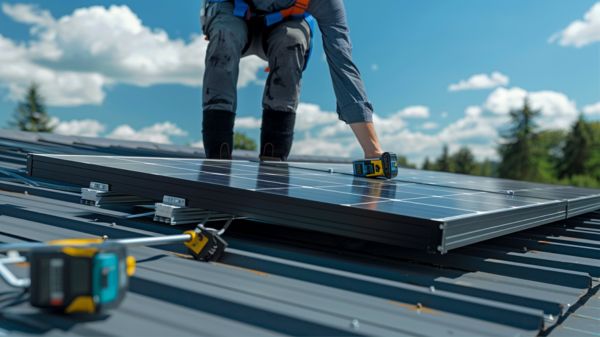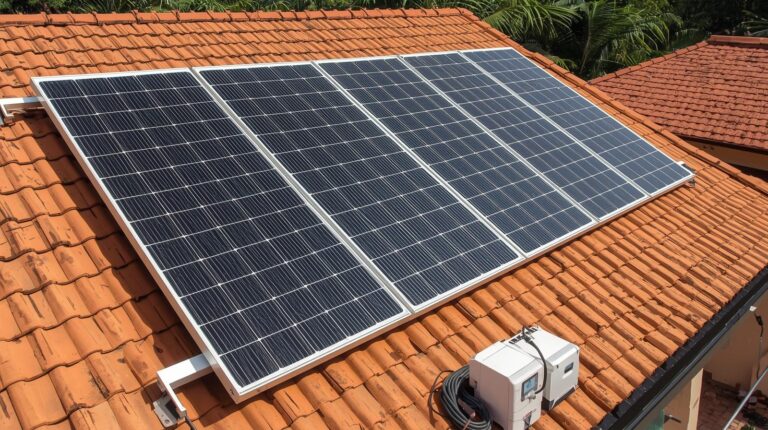The decision to install a DIY solar power system is multifaceted, driven by compelling factors such as cost savings, energy independence, and a reduced carbon footprint. And you’ll need the right setup guide to do it.
Beyond the immediate financial benefits, DIY enthusiasts gain a unique educational experience and the satisfaction of creating a customized solution tailored to their specific needs and budget. Additionally, the flexibility in installation and maintenance allows for greater control and adaptability.
However, the potential for financial incentives and long-term savings adds another layer of appeal. With these points in mind, what considerations should one weigh before starting on such a project?
Key Takeaways
- Save over $5,000 on installation costs by eliminating labor expenses.
- Gain energy independence and reduce vulnerability to power outages and rate hikes.
- Promote sustainability and reduce carbon emissions with renewable energy.
- Customize the system to fit your energy needs and budget.
- Enhance technical knowledge and skills in renewable energy technology through hands-on learning.
Cost Savings
Choosing a DIY solar power system can lead to significant savings in expenses, with possible reductions exceeding $5,000 compared to professional installations. This number arises from the elimination of labor expenses linked with professional installers. By tackling the installation process themselves, consumers can greatly decrease overall installation costs.
However, it is important to take into account that professional installers often secure wholesale discounts on solar panels, which can lower the initial cost of materials but may not be accessible to DIY enthusiasts.
Financing options provided by professional installers can make solar installations more economical through structured payment plans, a benefit often not available for DIY projects. Additionally, while professional installations typically come with thorough warranties from both manufacturers and installers, DIY setups might lack such assurances, posing a potential risk for long-term reliability.
Furthermore, the availability of tax incentives and rebates can further impact the cost-effectiveness of a solar installation. These financial aids are sometimes not applicable to DIY installations, potentially reducing the overall savings.
Hence, while DIY solar power systems can offer substantial savings upfront, the long-term financial benefits must be carefully assessed against the potential absence of warranties, rebates, and financing options.
Related Post: The 6 Best DIY Solar Power Kits for Homes: Our Top Picks for You.
Energy Independence
While the cost savings of a DIY solar power system are compelling, an equally important benefit is the energy independence it offers, empowering homeowners to generate their electricity and mitigate reliance on the grid. This autonomy over energy production, storage, and consumption yields several significant advantages.
- Control and Security: Homeowners can manage their energy production and storage, ensuring a continuous power supply, particularly during power outages or emergencies. This security is invaluable in instances where grid reliability is compromised.
- Financial Benefits: By reducing reliance on the grid, DIY solar power systems help homeowners significantly decrease utility bills and achieve long-term savings. The ability to generate electricity independently means less vulnerability to fluctuating energy prices and utility rate hikes.
- Sustainable Living: Embracing energy independence with DIY solar power systems enables homeowners to lower their carbon footprint. This shift not only reduces the environmental impact but also contributes to a sustainable and self-sufficient lifestyle.
Environmental Impact
Implementing a DIY solar power system can play a pivotal role in reducing carbon emissions, thereby addressing the urgent need for climate change mitigation. DIY solar projects harness renewable energy, markedly lowering the consumption of fossil fuels, which are notorious for their high greenhouse gas emissions.
Solar panels, by producing clean electricity, eliminate the release of harmful pollutants, contributing to a notable reduction in air pollution and environmental degradation.
The environmental impact of DIY solar systems is profound. By shifting to renewable energy sources, these projects promote sustainability and reduce the strain on non-renewable resources. This shift not only mitigates the adverse effects of climate change but also fosters a healthier ecosystem.
Solar energy systems, by avoiding the depletion of finite natural resources, guarantee the longevity of energy supplies for future generations.
Additionally, embracing DIY solar projects aligns with the global movement towards a greener future. As communities adopt these systems, they collectively diminish their carbon footprint. This combined effort results in a substantial decrease in greenhouse gases, propelling society towards a sustainable and environmentally responsible energy paradigm.
The adoption of DIY solar power systems is, thus, a critical step in achieving long-term environmental sustainability and climate resilience.
Educational Experience
Engaging in the installation of a DIY solar power system offers a substantial hands-on learning opportunity. It fosters technical proficiency in renewable energy technology. This process enhances understanding of solar panel components, wiring, and system design. It equips individuals with the skills necessary for effective troubleshooting and maintenance.
Additionally, the practical experience gained contributes to an expanded knowledge base in sustainable energy practices. This is supported by a wealth of educational resources and online tutorials.
Hands-On Learning Opportunity
Installing a DIY solar power system provides a practical, hands-on learning experience that deepens understanding of renewable energy technology and system optimization. By engaging in DIY solar installations, individuals gain valuable practical knowledge in solar panel installation, wiring, and system optimization, which enhances their grasp of energy efficiency and sustainable living practices.
Here are three key benefits:
- Enhanced Practical Knowledge: DIY solar installations offer a detailed understanding of the components and processes involved in solar power systems. This hands-on learning translates to better energy efficiency and system performance.
- Empowerment Through Self-Sufficiency: Installing your own solar power system fosters a sense of accomplishment and self-sufficiency. This empowerment is particularly appealing to those seeking liberation from traditional energy sources, enabling more informed decisions about energy usage and conservation.
- Positive Environmental Impact: Gaining firsthand experience in renewable energy technology allows individuals to comprehend the broader environmental impact of their energy choices. This understanding encourages sustainable living practices and a commitment to reducing carbon footprints.
Renewable Energy Knowledge Expansion
Delving into a DIY solar power system project greatly expands one’s technical proficiency and understanding of renewable energy systems, offering a thorough educational experience grounded in real-world applications.
This immersive hands-on experience provides a detailed understanding of system design, energy efficiency, and sustainability practices. By engaging in a DIY solar power installation, individuals can deepen their knowledge of photovoltaic technology, battery storage solutions, and electrical wiring principles.
| Aspect | Knowledge Gained |
|---|---|
| System Design | Mastery of designing efficient solar setups |
| Energy Efficiency | Insights into optimizing energy consumption |
| Sustainability Practices | Practical application of eco-friendly methods |
| Photovoltaic Technology | Understanding solar panel functionality |
| Battery Storage | Skills in managing energy storage solutions |
These practical insights not only enhance one’s technical skills but also provide a clear understanding of solar panel performance, maintenance, and optimization strategies. Such projects illuminate the environmental and financial benefits of renewable energy, empowering individuals with the ability to implement sustainable solutions.
Customization
Customization in DIY solar power systems offers tailored energy solutions that align with specific consumption patterns and financial limitations. By allowing personalized system design, users can select components such as panels, batteries, and inverters that optimize performance and cost-efficiency.
Moreover, unique installation flexibility guarantees the system can be expanded or modified to accommodate future energy needs and integrate advanced smart technologies for enhanced monitoring and control.
Tailored Energy Solutions
Tailoring a DIY solar power system to specific energy needs and spatial constraints allows for maximized efficiency and cost-effectiveness, optimizing best performance and longevity.
Customization in DIY solar power systems provides options to align with unique energy requirements and budget constraints, maximizing both energy output and financial investment. This approach can lead to significant cost savings and environmental benefits by selecting appropriate panel types and configurations.
- Panel Types and Sizes: Choosing the right panel types and sizes is essential. Monocrystalline panels, for instance, offer higher efficiency but at a higher cost, whereas polycrystalline panels are more budget-friendly but slightly less efficient. Customizing these choices based on energy needs can optimize performance.
- System Configuration: The flexibility to configure the arrangement of panels ensures optimal sunlight exposure. This includes deciding between ground-mounted or rooftop installations, which can be tailored to available space and local weather conditions, maximizing energy production.
- Budget and Energy Optimization: By tailoring the system to specific budget constraints and energy needs, users can achieve a balance between initial investment and long-term savings. Proper customization ensures that the system remains within financial limits while meeting energy demands efficiently.
Ultimately, a well-tailored DIY solar power system enhances performance and longevity, aligning with both economic and environmental goals.
Personalized System Design
A personalized system design in DIY solar power systems enables homeowners to select and configure the best combination of solar panels, batteries, and inverters, ensuring accurate alignment with their unique energy demands and financial parameters. This customization allows for a tailored approach where each component is carefully chosen to meet specific energy needs and budget constraints.
By opting for a personalized system design, homeowners can guarantee optimal sun exposure and energy production, greatly enhancing the efficiency and performance of their solar power systems. The flexibility in components selection—ranging from high-efficiency solar panels to advanced battery storage solutions—provides an unparalleled opportunity to maximize energy savings and sustainability.
Moreover, the capacity to customize system size and placement empowers users to create a setup that perfectly fits their property’s layout and geographical location, thereby optimizing energy capture and utilization. This level of control is instrumental in achieving long-term financial and environmental benefits, as it enables a strategic alignment of investment costs with expected energy outputs.
In essence, DIY solar power systems with personalized system design offer a liberating pathway to energy independence, providing both economic and ecological advantages through meticulously tailored and highly efficient solar energy solutions.
Unique Installation Flexibility
Unique installation flexibility in DIY solar power systems empowers homeowners to adapt their setups to specific spatial configurations and energy consumption patterns, thereby enhancing overall system efficiency. This customization capability enables precise tailoring to individual energy needs and space constraints, ensuring that every square foot and watt is utilized effectively.
- Panel Orientation and Tilt Angle: With DIY solar power systems, homeowners can meticulously adjust the panel orientation and tilt angle to capture maximum sunlight. Proper alignment can greatly boost energy production, especially in regions with varying sun exposure throughout the year.
- System Size Customization: The ability to select the appropriate system size is another advantage. Homeowners can determine the number and type of panels, inverters, and batteries that suit their specific energy requirements and budget constraints. This customization ensures that the system is neither overbuilt nor underpowered.
- Component Selection: DIY installations provide the freedom to choose high-efficiency components tailored to individual preferences. This includes advanced inverters and storage solutions that enhance overall energy savings and system performance.
In essence, the unique installation flexibility of DIY solar power systems facilitates a highly customized approach, enabling homeowners to maximize energy savings and achieve efficient energy production while overcoming space constraints. This liberation in system design fosters both economic and environmental benefits, driving the shift towards sustainable energy.
Maintenance and Upkeep
Regular maintenance and careful upkeep are important for guaranteeing the best performance and longevity of DIY solar power systems. Proper maintenance includes several key activities, such as cleaning panels, checking connections, and monitoring energy production.
Regular maintenance guarantees that accumulated dirt and debris do not obstruct sunlight, which is essential for maximizing energy capture and efficiency. Additionally, inspecting and securing connections can prevent potential energy losses and safety hazards.
Ensuring optimal battery health and inverter functionality is equally vital for the efficient operation of DIY solar power systems. Batteries should be regularly checked for charge levels and any signs of wear or damage. The inverter, which converts the generated DC electricity into usable AC power, must be monitored to ensure it is functioning correctly.
Regular checks can proactively address minor issues before they escalate into costly repairs. Furthermore, the ability to troubleshoot and promptly resolve issues is crucial for maintaining the system’s reliability.
Regular maintenance can greatly extend the lifespan of DIY solar panels and maximize energy savings, ultimately enhancing the return on investment. By dedicating time to upkeep, system owners can enjoy long-term energy liberation and financial benefits.
Financial Incentives
While regular maintenance guarantees peak performance and longevity of your solar power system, understanding the array of financial incentives available can greatly reduce the initial investment and enhance overall cost-efficiency.
Finding your way through these incentives allows you to maximize both immediate and long-term savings, making the shift to solar power more accessible and financially viable. Several financial incentives can lower the cost of installing DIY solar panels:
- Federal Tax Credits: Homeowners can claim up to 30% of the total system cost as a federal tax credit, providing substantial savings on your initial investment.
- Local Incentives: Various states and municipalities offer additional rebates and grants that further alleviate financial burdens. These can be layered on top of federal tax benefits for even greater cost reductions.
- Financing Options: Solar loans and leases present viable options to spread out the cost over time, making DIY solar installations more affordable. Solar loans typically offer favorable interest rates, while solar leases can enable immediate access to solar energy without the upfront expense.
However, it is important to note that certain rebates and incentives might only apply to professionally installed systems, limiting the financial benefits for DIY installations. By strategically utilizing these incentives, you can achieve greater financial independence and long-term savings on electricity bills.
Related Post: 5 Best Government Solar Incentives for Homeowners Explained.
Conclusion
Opting for a DIY solar power system delivers substantial financial benefits, enhanced energy autonomy, and a reduced ecological footprint. The hands-on installation process provides valuable knowledge in renewable energy technologies, allowing for system customization to meet specific requirements and budget limitations.
Additionally, DIY systems afford greater control over maintenance and upkeep. Coupled with available financial incentives, these advantages make DIY solar installations a strategic and economically viable choice for sustainable energy solutions.




